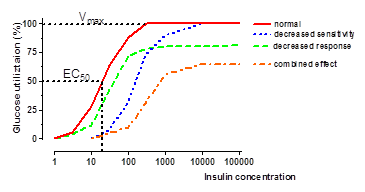III.3.B.e. Insulin resistance
Insulin resistance means that insulin cannot exert an effect on the liver, on the muscles or on the adipose tissue.
Insulin resistance is defined as a decreased insulin response (the maximal effect of insulin) and/or decreased insulin sensitivity (half the insulin concentration required for the maximal effect) on a target tissue (Fig. 5).
The efficiency of insulin resistance can be defined by biological measurements:
Glu uptake by the muscles,
inhibition of liver Glu production,
inhibition of fat breakdown (lipolysis).

Figure 5. The effects of insulin on Glucose utilization
(insulin sensitivity (EC50) and efficiency of insulin effect (Vmax))
Insulin resistance may cause a decrease of sensitivity or efficiency, but it may also have a combined effect.
The Glu uptake in the tissues is decreased, while the Glu production in the liver is increased by insulin resistance. This leads to hyperglycemia and a high blood Glu level. Insulin production is decreased by hyperglycemia, and a high blood Glu level is enhanced.
Insulin resistance is the main risk factor of the MetS, but pregnancy or puberty may decrease the insulin sensitivity. The decreased level suggests increased levels of the insulin antagonist hormones (growth hormone, glucocorticoids and catecholamine). Other pathophysiological mechanisms which may decrease insulin sensitivity: increased osmolality (drying), damaged insulin receptors or the excess taking of diuretic drugs.
Insulin resistance mainly develops in obese and/or T2DM patients.
0.4-0.85 IU insulin/kg is sufficient for T1DM patients to maintain Glu homeostasis. A dose of 1.0-1.20 IU insulin/kg suggests insulin resistance.